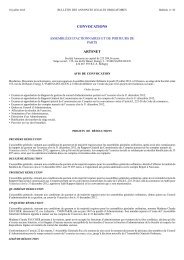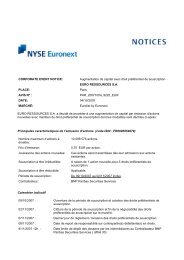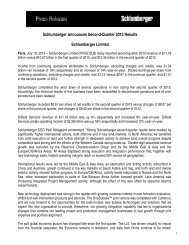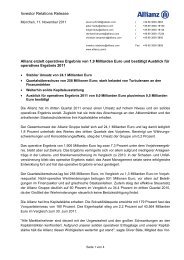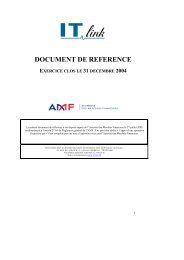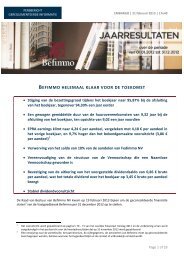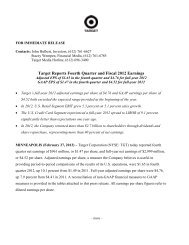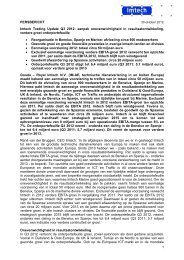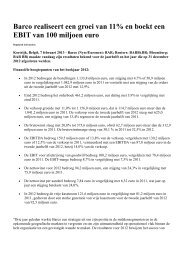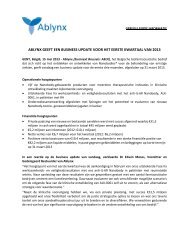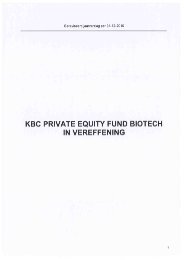FORM 10-Q
FORM 10-Q
FORM 10-Q
You also want an ePaper? Increase the reach of your titles
YUMPU automatically turns print PDFs into web optimized ePapers that Google loves.
Intangible assets acquired in recent transactions are naturally more susceptible to impairment, primarily due to the fact that they are recorded at fair value<br />
based on recent operating plans and macroeconomic conditions present at the time of acquisition. Consequently, if operating results and/or macroeconomic<br />
conditions deteriorate shortly after an acquisition, this could result in the impairment of the acquired assets. A deterioration of macroeconomic conditions may<br />
not only negatively impact the estimated operating cash flows used in our cash flow models, but it may also negatively impact other assumptions used in our<br />
analyses, including, but not limited to, the estimated cost of capital and/or discount rates. Additionally, as discussed above, in accordance with accounting<br />
principles generally accepted in the United States, we are required to ensure that assumptions used to determine fair value in our analyses are consistent with<br />
the assumptions a hypothetical marketplace participant would use. As a result, the cost of capital and/or discount rates used in our analyses may increase or<br />
decrease based on market conditions and trends, regardless of whether our Company's actual cost of capital has changed. Therefore, if the cost of capital<br />
and/or discount rates change, our Company may recognize an impairment of an intangible asset or assets in spite of realizing actual cash flows that are<br />
approximately equal to, or greater than, our previously forecasted amounts.<br />
The Company did not record any significant impairment charges related to intangible assets during the three months ended March 29, 2013, and March 30,<br />
2012.<br />
OPERATIONS REVIEW<br />
Sales of our nonalcoholic ready-to-drink beverages are somewhat seasonal, with the second and third calendar quarters accounting for the highest sales<br />
volumes. The volume of sales in the beverage business may be affected by weather conditions.<br />
Our organizational structure as of March 29, 2013, consisted of the following operating segments, the first six of which are sometimes referred to as "operating<br />
groups" or "groups": Eurasia and Africa; Europe; Latin America; North America; Pacific; Bottling Investments; and Corporate. Effective January 1, 2013,<br />
the Company transferred our India and South West Asia business unit from the Eurasia and Africa operating segment to the Pacific operating segment.<br />
Accordingly, all prior period segment information presented herein has been adjusted to reflect this change in our organizational structure. For further<br />
information regarding our operating segments, refer to Note 15 of Notes to Condensed Consolidated Financial Statements.<br />
Structural Changes, Acquired Brands and New License Agreements<br />
In order to continually improve upon the Company's operating performance, from time to time we engage in buying and selling ownership interests in bottling<br />
partners and other manufacturing operations. In addition, we also acquire brands or enter into license agreements for certain brands to supplement our beverage<br />
offerings. These items impact our operating results and certain key metrics used by management in assessing the Company's performance.<br />
Unit case volume growth is a key metric used by management to evaluate the Company's performance because it measures demand for our products at the<br />
consumer level. The Company's unit case volume represents the number of unit cases (or unit case equivalents) of Company beverage products directly or<br />
indirectly sold by the Company and its bottling partners to customers and, therefore, reflects unit case volume for both consolidated and unconsolidated<br />
bottlers. Refer to the heading "Beverage Volume" below.<br />
Concentrate sales volume represents the amount of concentrates and syrups (in all cases expressed in equivalent unit cases) sold by, or used in finished<br />
products sold by, the Company to its bottling partners or other customers. Refer to the heading "Beverage Volume" below.<br />
Our Bottling Investments operating segment and our other finished product operations, including our finished product operations in our North America<br />
operating segment, typically generate net operating revenues by selling sparkling beverages and a variety of still beverages, such as juices and juice drinks,<br />
energy and sports drinks, ready-to-drink teas and coffees, and water products, to retailers or to distributors, wholesalers and bottling partners who distribute<br />
them to retailers. In addition, in the United States, we manufacture fountain syrups and sell them to fountain retailers such as restaurants and convenience<br />
stores which use the fountain syrups to produce beverages for immediate consumption, or to authorized fountain wholesalers or bottling partners which resell<br />
the fountain syrups to fountain retailers. For these consolidated finished product operations, we recognize the associated concentrate sales volume at the time<br />
the unit case or unit case equivalent is sold to the customer. Our concentrate operations typically generate net operating revenues by selling concentrates and<br />
syrups to authorized bottling and canning operations. For these concentrate operations, we recognize concentrate revenue and concentrate sales volume when we<br />
sell concentrate to the authorized unconsolidated bottling and canning operations, and we typically report unit case volume when finished products<br />
manufactured from the concentrates and syrups are sold to the customer. When we analyze our net operating revenues we generally consider the following four<br />
factors: (1) volume growth (unit case volume or concentrate sales volume, as appropriate), (2) structural changes, (3) changes in price, product and geographic<br />
mix and (4) foreign currency fluctuations. Refer to the heading "Net Operating Revenues" below.<br />
"Structural changes" generally refers to acquisitions or dispositions of bottling, distribution or canning operations and consolidation or deconsolidation of<br />
bottling and distribution entities for accounting purposes. Typically, structural changes do<br />
27



